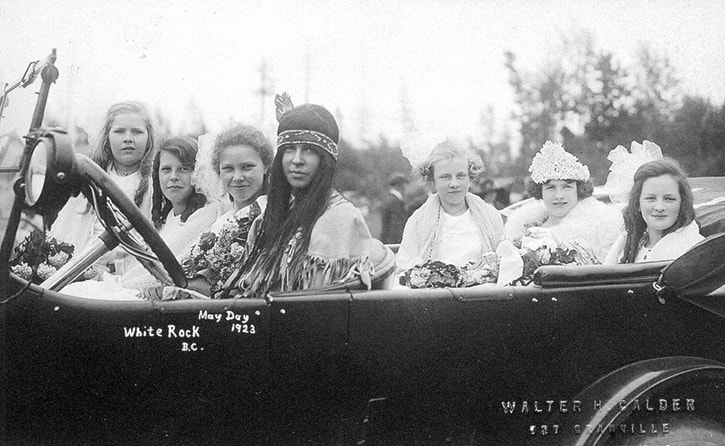White Rock has been an ideal stage for community events since the population was large enough to support social gatherings.
One of the most enduring annual events, May Day, was started in 1923 by the newly formed Parent Teachers Association. Incorporating the traditions and loyalties of the predominantly British citizenry, the first pageant was held on Empire Day at the school grounds.
Inevitably, the festivities included a parade, topped off with dancing at Vidal’s Auditorium on the waterfront in the evening. Expenses for the event were $177.84, offset by income of $212.20.
Candidates for May Queen qualified by being a White Rock resident (who judged, since White Rock had no official boundaries?); must have been in attendance at the White Rock Elementary School two successive terms; must have passed her 11th birthday, but not have reached her 14th birthday by May 24.
Names of eligible girls were put before the school population in a vote held before April 14, the top five voted on again, and the winning three declared the royal party.
The first May Queen was Marion McMillan, whose father worked at the Campbell River Lumber Company for a short time. Many of her successors, such as Billie Vidal, Cicely Russell, sisters Connie and Yvonne Dupraz, Meryl Barge, and Betty Lee were members of well-known families still remembered in the city.
Recently deceased Dorothy Reid Bentley, queen in 1934, had strong ties to the community: her father, Clifford, was a local immigration officer in the 1930s, her husband a local businessman, and her son, Rick, is married to the daughter of Peace Arch News founder Roy Jelly.
Another local early May Queen (1930), Shirley Bockus Dalgleish, and her husband, Alexander, have celebrated their 70th wedding anniversary. Shirley’s father, Casey Bockus, was in business with the legendary David Hughes, and like Hughes, very involved in community affairs.
Custom dictated that Harry Vidal or Henry Thrift performed the duties of MC during the first decade’s pageants. Police chief Bill Moffat, Casey Bockus, J. Champion, John Grant, Harry Hayward, Harold Downey, W.D. Kerfoot and Roger Garstang were among those who later took on the responsibility. Eva Henry provided executive continuity, serving as vice-president and chaperone from 1932 to 1941.
Because of the lean years of the Depression, no May Day celebration was held in 1938 or 1939.
Revivals in 1940 and 1941 were tentative. Perhaps in the spirit of the times, an announcement on the front page of the May 23, 1941 edition of the Semiahmoo Sun stated: “A bomb will be used as a signal to indicate whether or not there will be a May Day. If the signal is not fired at 11 a.m., no celebration will be held.”
It seems the bomb went off.
Although no May Days were celebrated for the remainder of the war, 1946 saw the restoration of the ceremony with one very visible change.
“When the time came to have the crowning in 1946, I was in Grade 12. We didn’t want to wear those short frilly dresses,” remembered Betty (Lee) Fernyhaugh, speaking of the ritual of the former queen crowning the newly elected one.
Perhaps it was the writing on the wall, and the event had run its course. The reign of Valerie Crockford in 1949 brought the event to a close.
Reactions to its demise from former participants were predictably regretful.
“It was a real highlight of the year. Every kid in school was involved in it,” recalled Lynn (Woolard) Bucholtz, flower girl in 1941.
Shirley Dalgleish summed it up this way: “I wouldn’t say I blame the teachers, but I don’t think the (later) teachers were as interested in the May Day. The teachers that we had were really interested in the event, but then the school got bigger, and it was a bigger responsibility, so you can’t blame them.”
Another way of putting it might be, “The times they were a-changing.” Uptown White Rock was growing rapidly, and new ideas for summertime merrymaking were being persistently voiced.
The Peninsula’s best-known mother-and-son historians, Lorraine and Hugh Ellenwood, are dedicated to preserving history through the White Rock Museum & Archives. Call 604-541-2225, or email whiterockarchives@telus.net
